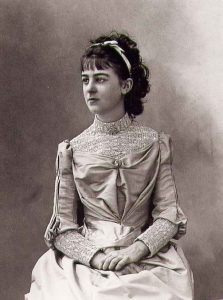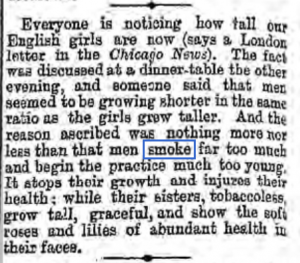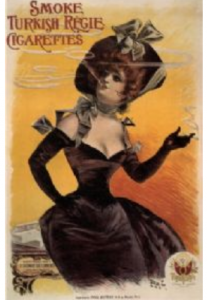A Smoking Rebellion at the Savoy?
Posted in 1800-1899, 19th Century, Events, people, restaurants and tagged with Layers of London, Savoy Hotel, Smoking, Social Norms, Victorian, Women, cigarettes, class, fin de siecle, gender, social history, strand, turn of the century

The Savoy hotel is a treasure trove of weird and intriguing events over the last century of Strand history. In 1896, per the Fairmont Hotel Group blog, the Duchesse de Clermont-Tonnerre was the first woman to smoke in public and did so at the Savoy.
“The Duchesse de Clermont-Tonnerre, the first woman to smoke in public, chose The Savoy as her venue. On this infamous evening in 1896, the Duchesse smoked not one, but many cigarettes while lingering at the dinner table.” Via Fairmont blog.
This little factoid raised a multitude of questions for me. Most obviously, who was the Duchesse de Clermont-Tonnerre? Secondly, what were the attitudes towards smoking at the turn of the century? More importantly, what were the attitudes towards women doing so? Finally, how realistic of a claim is it that she was the first woman to smoke in public, and at the Savoy hotel of all places?
Who was the Duchesse de Clermont-Tonnerre?

Elisabeth Gramont, 1889, via marcelproust.it
Firstly, let us focus on the person concerned: Duchesse de Clermont-Tonnerre.
Here is the woman in question, posing in 1889, only seven years before the supposed smoking scene. The Duchesse’s original name was Elisabeth Gramont, according to Francesco Rapazzini, whose article provides the basis for this whole biography.
Rapazzini writes that the Duchesse “came from one of the oldest and most important French families, the Dukes of Gramont”. Her father insisted she marry, and on 3 June 1896 she conceded with her union to Philibert de Clermont-Tonnerre. Rapazzini explains that her marriage was a desperately unhappy one due to her husband’s violent tendencies. Eventually, Elisabeth got involved in intellectual circles in France which included Marcel Proust. This led to her meeting Natalie Clifford Barney in April 1909. Barney was a poet, academic, socialite, and had been in several same-sex partnerships before meeting Gramont. The two eventually became lovers and long-term companions.
All that rather lengthy introduction leads me to the conclusion that Elisabeth was a very particular person for the time. She ran in avant-garde intellectual circles and was happily in a same-sex partnership, though technically still married to her abusive husband. All this seems to point to her being something of a ‘rule-breaker’. This lends credence to the idea of her going out of her way to break social norms in 1896, the year she was forced to marry her horrible husband. So, on that basis, the smoking rumour holds water.
Victorian views on smoking?
Next to explore are Victorian views on smoking and, more precisely, women smoking. Looking online led me to a blog post by Dr Bruce Rosen ‘Smoke, smoke, smoke that cigarette‘. His post is full of information on Victorian attitudes, however this particular extract is useful to our present investigation:
“As late as 1891, a report appeared in Lloyd’s Weekly Newspaper of a row which erupted in a café when a woman tried to light her cigarette and was told women were not allowed to smoke there.” Via Bruce Rosen’s blog.
Intrigued, I tried to trace back this article by going through all 52 editions of the Lloyds weekly newspaper of 1891 to find proof of this event occurring.
However, I have had no luck tracking down the row that Dr Rosen mentioned. Perhaps because I didn’t delve into the national edition of the paper? For all anyone knows, that article could have occurred anywhere in the country.
Yet, all clouds have a silver lining because I found other articles concerning smoking which help to explore the Duchesse’s story.
Newspaper evidence:

Lloyds newspaper – 3rd of March 1891
- On the Sunday 3 May 1891 edition, Lloyds newspaper claimed that men were “growing shorter in the same ratio as the girls grew taller. And the reason ascribed was nothing more nor less than men smoke far too much and begin the practice much too young”. From this we must conclude that smoking was not widespread, or practiced in excess, since writer supposes that British women were not suffering the same effects. This supports that the Duchesse’s smoking was unusual.
- On the 23 August 1891, the newspaper stated, “nothing looks worse than a girl smoking in public”. While that proves that public attitude was against the Duchesse, it also implies that it had already happened by 1891, five years before the story supposedly occurred.
More than meets the eye?
This tone of the second article, judging women who smoked, struck me as something to investigate a little more. The writer certainly implies that smoking was not appreciated, yet women were doing it anyway.

Smoke Turkish Regie Cigarettes. Vintage French Advertising poster.
The following advertisement for the Turkish Regie Cigarette company from 1895, by French artist Jean de Paléologue, shows a woman in all black smoking.
Though made by a Frenchman, the poster is written in English, which implies it targeted an Anglophone audience. It seems unlikely that first time a woman smoked in public was a year after this advert was released. Clearly, women smoking were already in the public eye.
Further contextual evidence
3. Lastly, on the 6December 1891, a woman by the name of Lady Russel filed a suit against her husband for maltreatment, in part because he “limited her smoking to six cigarettes a day”. The suit was eventually won by Mr Russel, as the court sided with him. Therefore, it is clear that women were already smoking, though this seems to be limited to the home life. Moreover, the court siding with her husband, while completely unsurprising for Victorian Britain also reminds the reader that even elite women were very much second-class citizens. Since smoking was not something women were ‘supposed’ to have control over, the Duchesse’s defiance would be noteworthy.
Conclusion
So, how likely is the story that the Duchesse de Clermont-Tonnerre was the first woman to smoke in public?
I am certainly willing to believe that Elisabeth Gramont did indeed smoke several cigarettes in defiance of Victorian norms. This seems very much in keeping with her character, and avant-garde lifestyle. As to whether she was the first to do so in public, I believe that is erroneous. It is more plausible that she was the first woman of ‘good-standing’, or notable socialite, to smoke in public, or the first to do so at the Savoy.
As the blogpost by Dr Rosen points out “While women of the better classes generally eschewed tobacco, at least until the latter years of the century, poorer women enjoyed smoking”. I am more inclined to think that Elisabeth Gramont was fighting Victorian norms for her class, than for her gender. I believe that the story is more a matter of half-truths, although it is certainly fascinating. In any case, it makes for some good publicity for the hotel.

[…] Savoy. However, there are other claims on the Fairmont Hotel Group blog that I have found to be a little erroneous. Moreover, scientists from the University of Birmingham published a paper in 2010 which poked holes […]